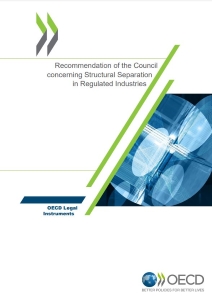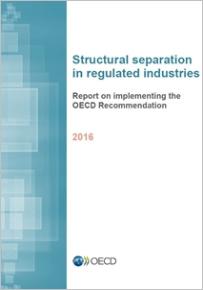Concurrence
Recommendation concerning Structural Separation in Regulated Industries
Download the text of the RecommendationEnglishFrançais
On 26 April 2001, the OECD Council adopted a Recommendation concerning Structural Separation in Regulated Industries. It calls for governments to consider structural separation, in particular the pros and cons of separating the structure of a regulated firm's activities. |
|
Rationale for the Recommendation When a firm provides products or services regulated by government, structural separation may be required so as not to hinder the entry of competitors in the market. “Structural separation” of a firm may be important to advance the process of market liberalisation. It is applied notably in sectors such as electricity and telecommunications where the main service (or product) is generally provided by a supplier and other firms commercialise the end product or service to consumers. The issuing of a recommendation became necessary to draw attention to the benefits of structural separation but also to clarify since it may not always bring economic and public benefits that justify its implementation. Governments should therefore carefully assess the costs and benefits of structural versus behavioural measures especially in the context of privatisation, liberalisation or regulatory reform. Scope of the RecommendationThe recommendation applies to OECD member countries. Other economies are welcome to associate themselves with the recommendation. Implementation reports and the 2016 revisionThe Recommedation calls for regular implementation reports: a first report was issued in preparation of the 2001 recommendation, a second one was published in 2006 and a third report led to the revision of the Recommendation in 2011. The 2011 report showed that the impact of separation policies on investment incentives should also be amongst the benefits and costs assessed. It focused in particular on the electricity, gas, railways and telecommunications sectors. In 2016, a fourth report showed that structural separation remains a relevant remedy to advance the process of market liberalisation and that the areas of application can include vertically integrated industries where only some activities are subject to competitive constraints. Help us foster structural separation in regulated industriesThe Recommendation applies to OECD member countries but other economies worldwide are welcome to associate themselves to it. The Secretariat is strongly committed to support OECD and non-OECD governments with the implementation of the Recommendation. Romania has already adhered to the Recommendation. We invite other non-OECD economies interested in doing so to contact the OECD Secretariat at DAFCOMP.Contact@oecd.org. See also
|
2016 Report on implementing the OECD Recommendation on Structural Separation in Regulated IndustriesThis 2016 report analyses experiences of OECD countries in implementing the OECD recommendation on structural separation in regulated industries and concludes that structural separation remains a relevant remedy to advance the process of market liberalisation and that the areas of application can include vertically integrated industries where only some activities are subject to competitive constraints. Read the report (pdf) Lire le rapport (pdf) Previous reports: |
Documents and linksOther OECD Recommendations on Competition Law and Policy More about the work of the OECD on international co-operation and competition |
Documents connexes

